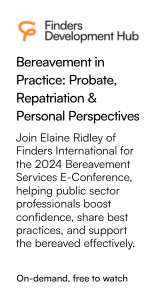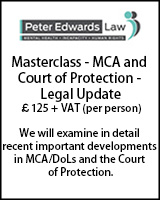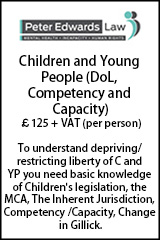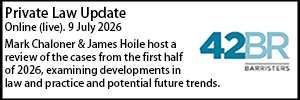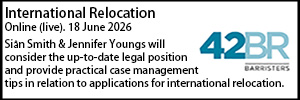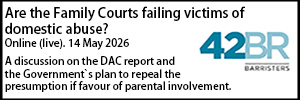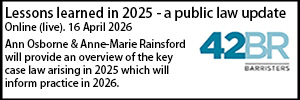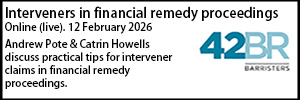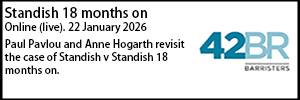Analysing the impact of Re B-S
- Details
 Tehniat Lindsay looks at the implications of Re B-S, the Court of Appeal's landmark ruling on adoption.
Tehniat Lindsay looks at the implications of Re B-S, the Court of Appeal's landmark ruling on adoption.
Did Re B–S [2013] EWCA Civ 1146 really change anything? Well, there is a simple answer to that – yes and no.
No as the law remains the same but yes as practice has been tightened up by practitioners and Judges.
There has always been a duty on local authorities to keep rehabilitation of a child to its family at the forefront and to always consider all options for the child’s permanency when care planning. A social worker should also evaluate which options could become realistic or feasible with support and monitoring being provided. Munby J commented that there were “real concerns” about the recurrent inadequacy of the evidence and analysis and reasoning put forward by local authorities and guardians.
Evidence
Whilst not changing the law, Re B-S has definitely raised the bar perhaps to what it ought to have always been when it comes to evidence. The case clarifies that the evidence must address all the options which are realistically possible – and must contain an analysis of the arguments for and against each option, in particular the nature and extent of the risk of harm involved in each option.
There has been ‘tightening up’ of the practice, not just by practitioners but also by Judges.
What has been the practical effect of Re B-S?
In Re E [2013] EWCA Civ 1614, an appeal by mother against care and placement orders, the principle from Re B-S was applied, ensuring that a care plan for adoption would be sanctioned only “if nothing else would do”. Here LJ McFarlane in the Court of Appeal undertook the test described by the Supreme Court in Re B [2013] UKSC 33 and looked at the proportionality of the outcome to the evidence of the case.
In this case, a care and placement order had been made. Mother’s boyfriend had been found at the Fact Finding Hearing to have caused harm to the child and mother had continued to live with the boyfriend for some months after the Fact Finding Hearing and before finding alternative accommodation. The Judge concluded that adoption for the young child away from the care of a mother who was otherwise seen as a loving and capable mother to whom the child is securely attached and away from a mother, against whom there were no adverse findings – was not a proportionate outcome.
Accordingly it was held that the decision at first instance was “wrong” in light of Re B. The care order and placement orders were set aside and an interim care order made again as the appeal to the care and placement order was allowed.
In another case post Re B-S, Re J [2013] EWCA Civ 1100, the Court of Appeal granted the grandmother of a child aged 21 months permission to appeal against care and placement orders, applying the Supreme Court’s decision in Re B. Here, the human rights implications were that the placement order must be “necessary”. The Courts have to give due consideration to the human rights and specifically Article 8, the right to respect private and family life and only permanently remove children from their biological families when it is necessary to do so. It was held that the judge at first instance did not explain why it was considered necessary to grant an adoption order rather than placing the child with the family.
McFarlane LJ states that it was “incumbent” on a judge to expressly set out why he had chosen adoption rather than the placement in the family.
The trial judge had referred to the test of the child’s welfare requiring parental consent to be dispensed with but did not explain why the child’s welfare required him to be placed for adoption. The judgment did not further consider the benefits and detriments of the child being adopted. This is the central question when a Court is deciding whether to make a placement order or not. The welfare checklist was not mentioned in the judgment either and therefore it was not clear what the thinking behind granting the placement order was.
Again, case law demonstrates no real change in law but definitely a change in the tightening up of the practices.
Whether or not a care order and an adoption order should be made was the question in Re HA (a child) [2013] EWHC 3634 (Fam). Here a mother had three older children, two of whom had died and there remained question marks as to whether mother had caused their deaths. Although it was held that the children were neglected by her, she sought a residence order and a supervision order in relation to her youngest child who was seven months old. Mother was extremely vulnerable and had admitted to having many relationships with men she had met on the internet. In examining and assessing the evidence before the Courts, further to the guidance in Re B-S a decision was made as to which order to make as the threshold was met. The judge considered that the test for severing a relationship between the parent and child is very strict and justifiable “only in exceptional circumstances and when motivated by overriding requirements pertaining to the children’s welfare”. In short, where nothing else will do. Lord Neuberger’s thinking from Re B was referred in Re B-S where he commented that adoption should be a last resort where nothing else was possible. What had to be shown was that the child’s welfare “required” parents’ consent to adoption to be dispensed with.
Here, both the options of rehabilitation and making the care and adoption order were comprehensively analysed with advantages and disadvantages of each were carefully considered before the decision made to grant the care and placement orders.
Leave to oppose adoption
Re B-S has definitely developed practice involving parental leave sought to oppose adoption.
The primary grounds for making an adoption order are that the provisions relating to parental consent are satisfied and that the making of the order is justified, paramount consideration having been given to the welfare of the child throughout his lifetime as set out in Section 1 of the Adoption and Children Act 2002.
Section 47 of the Adoption and Children Act 2002 governs the questions to be considered before an adoption order can be made. Section 47(5) specifically states that a parental guardian may not oppose the making of an adoption order without the Court’s leave and the Court cannot give leave … unless satisfied that there has been a change of circumstances.
Previously in 2010 the case of Re W and Re X and Y required there to be a “real possibility” that the Court will be persuaded to set aside the placement order. There were further comments such as “only in exceptionally rare circumstances” would an adoption be set aside after the making of the care and placement orders.
Further, in Re P [2007] this two stage test/process to determine whether or not to grant this type of leave to oppose adoption was developed. First of all, the Court has to be satisfied on the facts of the case that there has been a change in circumstances. If there had been a change in circumstances then the door to the exercise of judicial discretion to permit the parents who wished to defend the adoption proceedings was opened.
The decision then is governed by Section 1 of the Adoption and Children 2002 Act, i.e., the primary consideration of the Court must be the child’s welfare throughout his life in determining whether or not to grant the leave sought.
Noteworthy is McFarlane LJ’s comments about the misgivings with the old phrase of “exceptionally rare circumstances” when referring to the setting aside of an adoption. He said that those phrases were apt to mislead with potential serious adverse consequences. The intention was to provide the parents with an appropriate and a meaningful remedy by allowing them to be able to challenge the adoption.
As demonstrated in the following cases, practically speaking the following issues need to be analysed in making the decision whether or not to grant leave to oppose the making of an adoption order.
- Whether there has been a change of circumstances and whether the parent has solid grounds for seeking leave in the finding whether there are solid grounds seeking leave;
- Does the welfare of the child necessitate the refusal of leave?
In evaluating these intertwined issues, any judge would need to consider whether based on the change of circumstances, would the parent have solid grounds for seeking leave and if so would the child’s welfare necessitate refusal of leave or necessitate the granting of leave. Thus, considering the appropriate order for the child throughout his/her life.
In Re W and Re H [2013] EWCA Civ 1177, the two-stage test was reinforced i.e. whether or not to grant the parent leave to oppose adoption under Section 47(5). In the first case, the decision to refuse leave was set aside and the appeal allowed and in the second, permission to oppose granted mainly as the judgments in the first instance did not appear to consider the key issues.
Judge Barclay’s initial judgment in Re W considered whether it was “sensible” and possible to “unscramble the arrangements that were on-going for the children”. In this case the appeal was allowed as the key issues were not seen to have been considered in the judgment (whether or not the end result would be the same or not).
In Re L [2013] EWCA Civ 1481, a very sensible approach was taken in granting a mother’s application for leave to oppose an adoption order. This case considered mother’s circumstances and the changes that she had made including mother’s prospect of “successfully opposing the overall plan for adoption” it considered whether her case had substance and solidity. There was however a different feature in this case. This was that the child’s prospective adopters had separated and were going through a divorce. The adoptive mother had in fact withdrawn her application for adoption leaving an outstanding application by the adoptive father alone. The Judge had considered the possibility that the current adoptive placement may not ultimately succeed with the risk of the child being unsettled. The judge considered that the child’s “stability had been disturbed”. In addition mother had a solid case and in considering the child’s welfare it was determined that there was uncertainty in any event and therefore mother’s application for leave to oppose was granted.
In another case, Prospective Adopters v IA [2014] EWHC 331 (Fam) considered the question of whether or not to make a care order or a special guardianship order. There had been two applications for leave to appeal. One, as the application of paternal grandmother for a further assessment was refused and another on the making of a care and a placement order. Both were refused. An application to the European Court of Human Rights by the child’s father and paternal grandmother followed. Although the ECHR application was abandoned as father’s application to seek leave to oppose the making of an adoption order was considered.
The little girl concerned in this case was born prematurely and was severely disabled. She had never lived with her parents and had been in hospital for the first seven months of her life. She was then placed with foster carers who were also the prospective adopters. The judge had ruled out both the father and the paternal grandmother and mother was not actively involved.
In this case a change in circumstances was held to have taken place and leave to oppose granted under Section 47(5) as the initial judge in granting a care order did not and should have considered the arguments for the competing options of a special guardianship order and adoption. Therefore the prospects of success here were not fanciful and did have the required solidity. The judge did, however, make it clear that the options to be considered were only adoption order v a special guardianship order. It was a question for the judge to decide on the evidence of the competing options. It was held that ultimately the father was entitled to have the matter heard and determined properly and leave to oppose the adoption order was granted.
Looking at these developments in case law since Re B [2013], and more importantly Re B-S [2013], many advantages and benefits are seen in the “tightening up” process relating to evidence and also to the judgments being handed down. However, they do raise some thought provoking questions:
- Can it be said that the timescales of the child have once again been negotiated or extended since the care order/placement order stage? In those cases where a placement order was made, a decision has already been made that adoption was the best and final care plan for the child on the evidence and circumstances then. In some cases parents have had goodbye contacts with the child/ren after the making of a placement order. Further, the child in some cases has already been with foster carers from the date of protective measures/birth or has at least been in his/her permanent placement for considerable periods and formed attachments to carers. To consider not only if there has been any change in the parent’s circumstances but also to consider whether they have a chance at successfully challenging the technical making of the adoption order – as opposed to – having the child successfully rehabilitated to their care and being able to sustain the same, does have its weaknesses. From the child’s perspective, after such significant events in their journey have taken place, is it fair and in their best interests to “reverse the direction the child’s life has travelled”?
- The impact of appeals such as Re W Re H which lead to permission to oppose adoption being granted are bound to cause anxiety and distress to the applicant parent(s), prospective adopters and inevitably the child who is already placed with them.
- How is a change in circumstances submitted by the parents to be scrutinised in real terms? Mostly there is no expert or oral evidence and the decision whether or not to grant leave is based on submissions and/or on the evidence on paper submitted before the Courts. How feasible is it to scrutinise whether the change submitted on behalf of the parents has been on all aspects of concern which possibly led to the making of the care/placement order? What are the real limitations in gleaning evidence about this change?
- A child’s understanding when placed with prospective adopters will be that the placement/adoption is irrevocable. Life story work may have been undertaken to prepare them for their “forever placement”. However, these cases drive home the message to the child and the prospective adopters that in fact there is no certainty until the adoption order has actually been made. What will be the practical implication of this uncertainty on the drive to recruit more adopters particularly those from ethnic backgrounds given the current shortages?
- Whilst the case law highlights the importance of local authorities not rushing in to place a child for adoption without properly considering the alternatives, does this not contradict the Government’s drive to make the adoption process quicker and easier and to ultimately achieve permanence within the child’s timescales and within 26 weeks?
It remains to be seen whether the tightening up of care planning and the analysis of the evidence from the earliest stage possible will ensure that it becomes easier to determine cases where parents seek leave to oppose adoption. This is because once the clear streak of evidence and its analysis runs through the care, placement and adoption order stages, the correct order to make/not to make in the child’s welfare will be evident and clearer.
Family ties are only to be severed in very exceptional circumstances and everything must be done to preserve personal relationships especially where it is appropriate to rebuild the family. It remains to be seen and practitioners remain hopeful that the ‘shambolic’ and ‘insufficient’ evidence and analysis will become a thing of the past, with the high standards of evidence and analysis leading to clear arguments and judgments being made in the future.
Tehniat Lindsay is a lawyer at the London Borough of Lambeth. These views are her own and do not reflect those of the council. Tehniat can be contacted
























